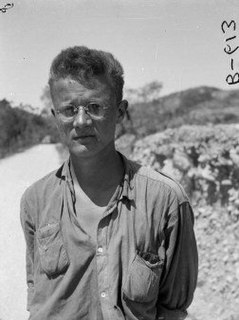
Cultural anthropology is a branch of anthropology focused on the study of cultural variation among humans. It is in contrast to social anthropology, which perceives cultural variation as a subset of a posited anthropological constant. The portmanteau term sociocultural anthropology includes both cultural and social anthropology traditions.
Early infanticidal childrearing is a term used in the study of psychohistory that refers to infanticide in paleolithic, pre-historical, and historical hunter-gatherer tribes or societies. "Early" means early in history or in the cultural development of a society, not to the age of the child. "Infanticidal" refers to the high incidence of infants killed when compared to modern nations. The model was developed by Lloyd deMause within the framework of psychohistory as part of a seven-stage sequence of childrearing modes that describe the development attitudes towards children in human cultures The word "early" distinguishes the term from late infanticidal childrearing, identified by deMause in the more established, agricultural cultures up to the ancient world.

In anthropology, kinship is the web of social relationships that form an important part of the lives of all humans in all societies, although its exact meanings even within this discipline are often debated. Anthropologist Robin Fox says that the study of kinship is the study of what humans do with these basic facts of life – mating, gestation, parenthood, socialization, siblingship etc. Human society is unique, he argues, in that we are "working with the same raw material as exists in the animal world, but [we] can conceptualize and categorize it to serve social ends." These social ends include the socialization of children and the formation of basic economic, political and religious groups.

Marshall David Sahlins was an American cultural anthropologist best known for his ethnographic work in the Pacific and for his contributions to anthropological theory. He was Charles F. Grey Distinguished Service Professor Emeritus of Anthropology and of Social Sciences at the University of Chicago.
Cultural ecology is the study of human adaptations to social and physical environments. Human adaptation refers to both biological and cultural processes that enable a population to survive and reproduce within a given or changing environment. This may be carried out diachronically, or synchronically. The central argument is that the natural environment, in small scale or subsistence societies dependent in part upon it, is a major contributor to social organization and other human institutions. In the academic realm, when combined with study of political economy, the study of economies as polities, it becomes political ecology, another academic subfield. It also helps interrogate historical events like the Easter Island Syndrome.

Julian Haynes Steward was an American anthropologist known best for his role in developing "the concept and method" of cultural ecology, as well as a scientific theory of culture change.
Leslie Alvin White was an American anthropologist known for his advocacy of the theories cultural evolution, sociocultural evolution, and especially neoevolutionism, and for his role in creating the department of anthropology at the University of Michigan Ann Arbor. White was president of the American Anthropological Association (1964).
Sociocultural evolution, sociocultural evolutionism or social evolution are theories of sociobiology and cultural evolution that describe how societies and culture change over time. Whereas sociocultural development traces processes that tend to increase the complexity of a society or culture, sociocultural evolution also considers process that can lead to decreases in complexity (degeneration) or that can produce variation or proliferation without any seemingly significant changes in complexity (cladogenesis). Sociocultural evolution is "the process by which structural reorganization is affected through time, eventually producing a form or structure which is qualitatively different from the ancestral form".
Ecological anthropology is a sub-field of anthropology and is defined as the "study of cultural adaptations to environments". The sub-field is also defined as, "the study of relationships between a population of humans and their biophysical environment". The focus of its research concerns "how cultural beliefs and practices helped human populations adapt to their environments, and how people used elements of their culture to maintain their ecosystems". Ecological anthropology developed from the approach of cultural ecology, and it provided a conceptual framework more suitable for scientific inquiry than the cultural ecology approach. Research pursued under this approach aims to study a wide range of human responses to environmental problems.
Neoevolutionism as a social theory attempts to explain the evolution of societies by drawing on Charles Darwin's theory of evolution while discarding some dogmas of the previous theories of social evolutionism. Neoevolutionism is concerned with long-term, directional, evolutionary social change and with the regular patterns of development that may be seen in unrelated, widely separated cultures.
Unilineal evolution, also referred to as classical social evolution, is a 19th-century social theory about the evolution of societies and cultures. It was composed of many competing theories by various anthropologists and sociologists, who believed that Western culture is the contemporary pinnacle of social evolution. Different social status is aligned in a single line that moves from most primitive to most civilized. This theory is now generally considered obsolete in academic circles.

Elman Rogers Service (1915–1996) was an American cultural anthropologist.
Ethnoecology is the scientific study of how different groups of people living in different locations understand the ecosystems around them, and their relationships with surrounding environments.
Cultural materialism is an anthropological research orientation first introduced by Marvin Harris in his 1968 book The Rise of Anthropological Theory, as a theoretical paradigm and research strategy. It is said to be the most enduring achievement of that work. Harris subsequently developed a full elaboration and defense of the paradigm in his 1979 book Cultural Materialism. To Harris social change is dependent of three factors: a society's infrastructure, structure, and superstructure.
Environmental anthropology is a sub-discipline of anthropology that examines the complex relationships between humans and the environments which they inhabit. This takes many shapes and forms, whether it be examining the hunting/gathering patterns of humans tens of thousands of years ago, archaeological investigations of early agriculturalists and their impact on deforestation or soil erosion, or how modern human societies are adapting to climate change and other anthropogenic environmental issues. This sub-field of anthropology developed in the 1960s from cultural ecology as anthropologists borrowed methods and terminology from growing developments in ecology and applied then to understand human cultures.
This bibliography of anthropology lists some notable publications in the field of anthropology, including its various subfields. It is not comprehensive and continues to be developed. It also includes a number of works that are not by anthropologists but are relevant to the field, such as literary theory, sociology, psychology, and philosophical anthropology.
Political Economy in anthropology is the application of the theories and methods of historical materialism to the traditional concerns of anthropology, including, but not limited to, non-capitalist societies. Political Economy introduced questions of history and colonialism to ahistorical anthropological theories of social structure and culture. Most anthropologists moved away from modes of production analysis typical of structural Marxism, and focused instead on the complex historical relations of class, culture and hegemony in regions undergoing complex colonial and capitalist transitions in the emerging world system.

American anthropology has culture as its central and unifying concept. This most commonly refers to the universal human capacity to classify and encode human experiences symbolically, and to communicate symbolically encoded experiences socially. American anthropology is organized into four fields, each of which plays an important role in research on culture:
- biological anthropology
- linguistic anthropology
- cultural anthropology
- archaeology
Cultural evolution is an evolutionary theory of social change. It follows from the definition of culture as "information capable of affecting individuals' behavior that they acquire from other members of their species through teaching, imitation and other forms of social transmission". Cultural evolution is the change of this information over time.
There are two main approaches currently used to analyze archaeological remains from an evolutionary perspective: evolutionary archaeology and behavioral ecology. The former assumes that cultural change observed in the archaeological record can be best explained by the direct action of natural selection and other Darwinian processes on heritable variation in artifacts and behavior. The latter assumes that cultural and behavioral change results from phenotypic adaptations to varying social and ecological environments.





